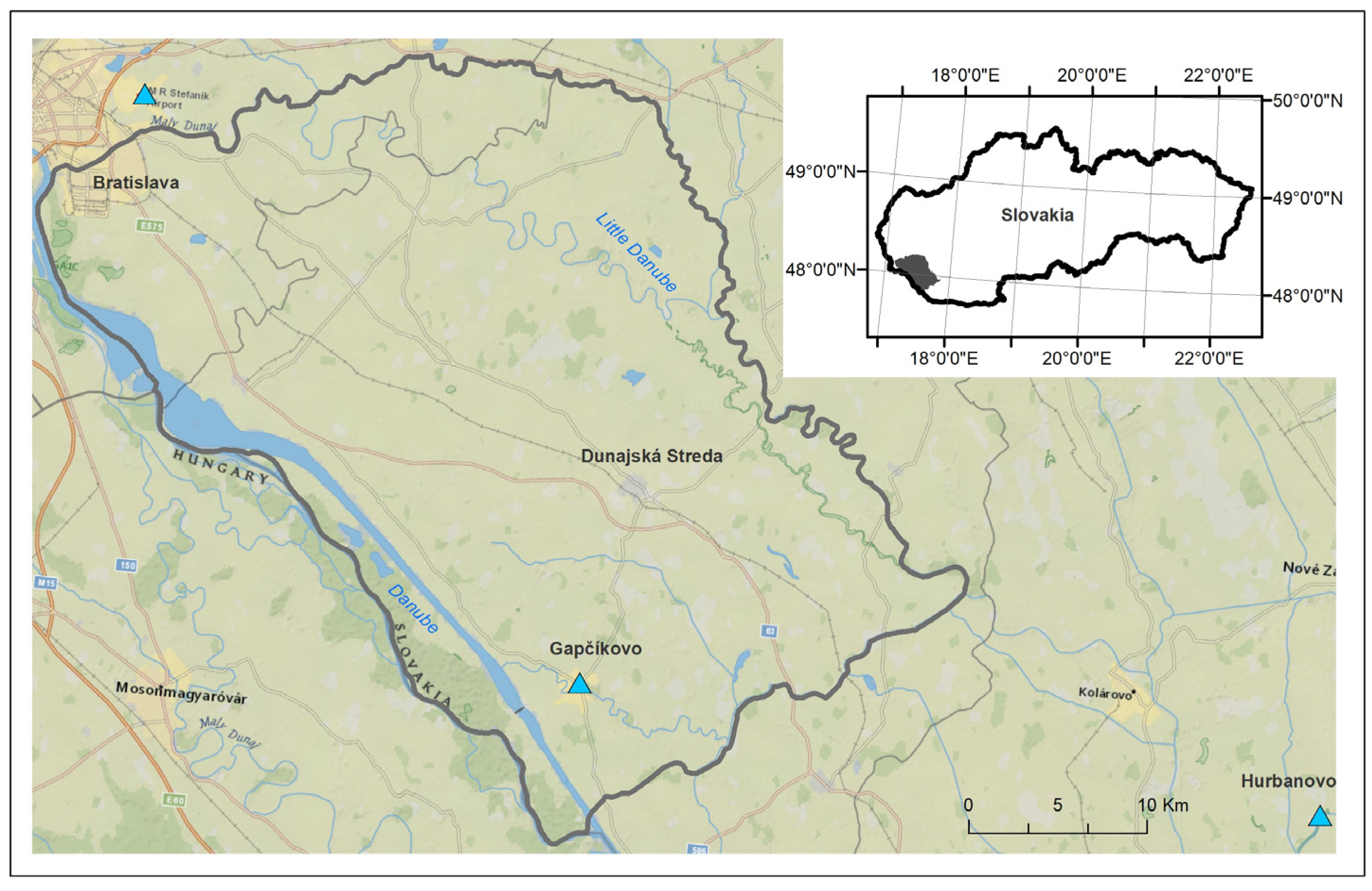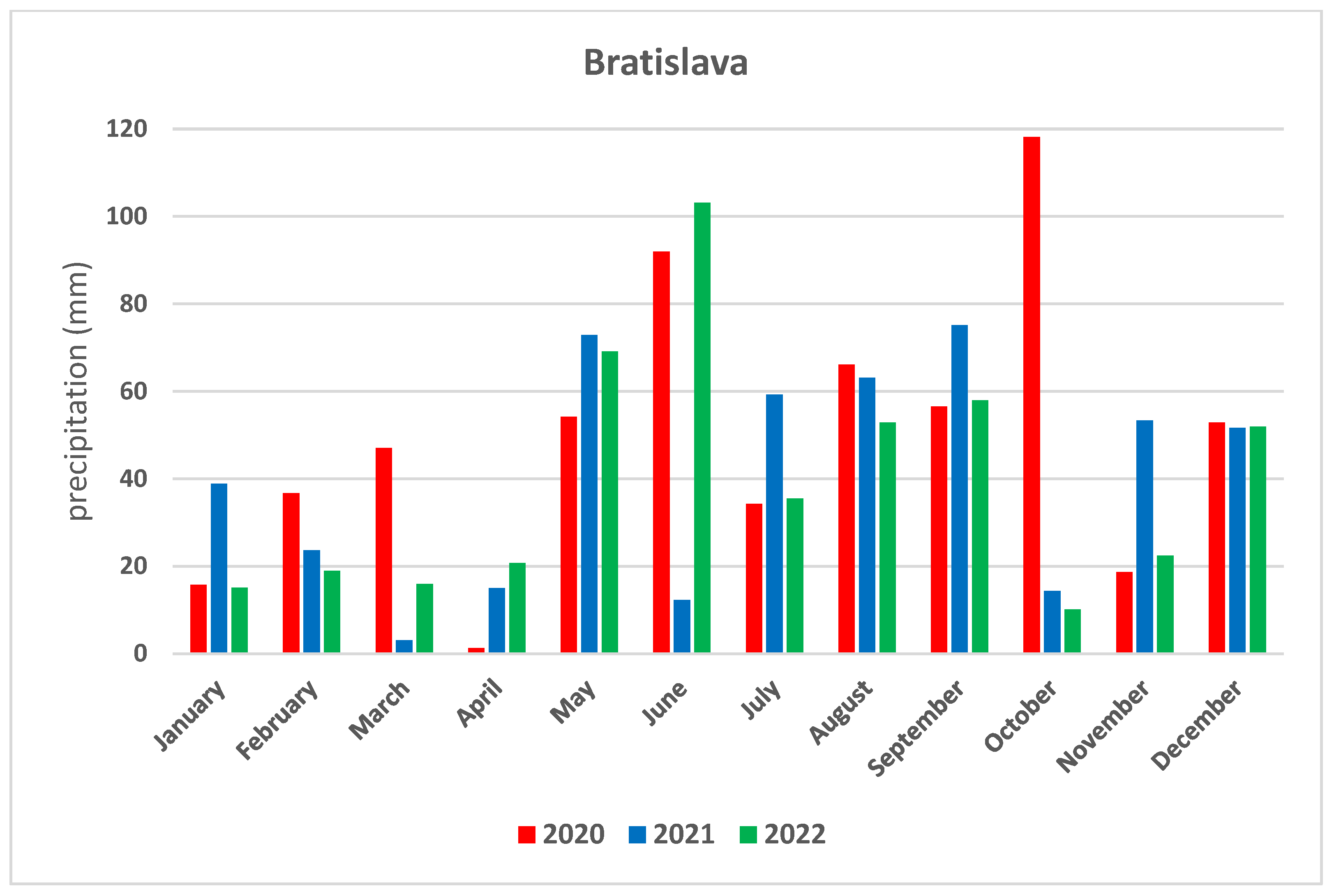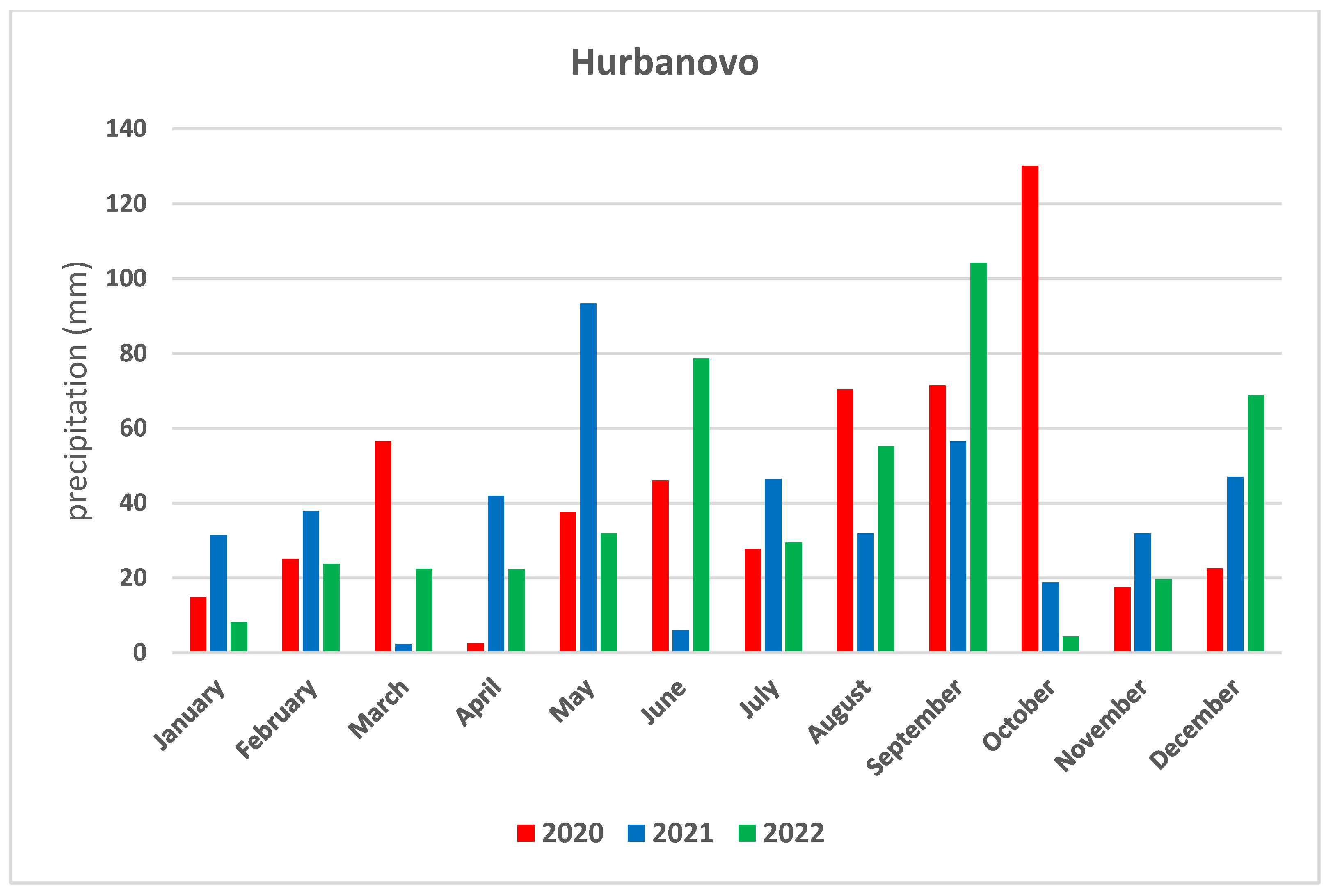Multifunctional Use of Agricultural Land with Support for Selected Ecosystem Services in the Territory Protected Water Management Area Žitný Ostrov
Abstract
:1. Introduction

- -
- Sustainable economic use of soils with the support for ecologization of agricultural technologies.
- -
- Non-productive land use and the cultural and social development of rural areas.
- -
- Protection and revitalization of the landscape and its components.
2. Methodology
2.1. Model Area
2.2. Methods
3. Results and Discussion
3.1. Characteristics of Soil Conditions
3.2. Proposal for Spatial Representation of Multifunctional Use of the Model Area
3.2.1. Sustainable Economic Use of Soils with Support for the Ecologization of Agricultural Technologies
- Highly productive soils (soil potential 10–9) 412 km2.
- Very productive soils (soil potential 8–7) 311.7 km2.
- Medium productive soils (soil potential 6–5) 159.5 km2.
3.2.2. Non-Productive Use of Land, and Cultural and Social Development of Rural Areas
- Less productive soils (soil potential 4–3) 43.3 km2.
- -
- Grass cover, which will help water retention in the landscape, increase biodiversity and overall soil amelioration, surface water, and groundwater quality in this area.
- -
- Planting groves, which will contribute to slope stabilization, a reduction in the risk of erosion by water or wind, mitigation of transport emissions effect, protection from wind and dust, improving the quality of water and soil, improvement to the microclimate, increased biodiversity, and, last but not least, aesthetic function.
- -
- The use of lower-quality soils (preserving or improving soil quality through strengthening the humus layer via extensive soil management).
- -
- Improvement to the air quality thanks to dust filtration by leaves (positive impact on climate by storing additional carbon in trunks, roots, leaves, and soil).
- -
- Reduction in burden using machinery (entering the new area, which has a future thanks to economic advantages and environment protection).
- -
- Safe and reliable income, which does not depend on the weather.
- -
- Low productive soils (soil potential 1–2) 1.9 km2.
3.2.3. Protection and Revitalization of the Landscape and Its Components
4. Conclusions
Author Contributions
Funding
Institutional Review Board Statement
Informed Consent Statement
Data Availability Statement
Conflicts of Interest
References
- Rodrigues, A.F.; Latawiec, B.J.; Reid, B.J.; Solórzano, A.; Schuler, A.E.; Lacerda, C.; Fidalgo, E.C.C.; Scarano, F.R.; Tubenchlak, F.; Pena, I.; et al. Systematic review of soil ecosystem services in tropical regions. R. Soc. Open Sci. 2021, 8, 201584. [Google Scholar] [CrossRef] [PubMed]
- AbdelRahman, M.A.E.; Shalaby, A.; Aboelsoud, M.H.; Moghanm, F.S. GIS spatial model based for determining actual land degradation status in Kafr El-Sheikh Governorate, North Nile Delta. Model. Earth Syst. Environ. 2018, 4, 359–372. [Google Scholar] [CrossRef]
- Bennett, E.M.; Peterson, G.D.; Gordon, L.J. Understanding relationships among multiple ecosystem services. Ecol. Lett. 2009, 12, 1394–1404. [Google Scholar] [CrossRef] [PubMed]
- Bommarco, R.; Kleijn, D.; Potts, S.G. Ecological intensification: Harnessing ecosystem services for food security. Trends Ecol. Evol. 2013, 8, 230–238. [Google Scholar] [CrossRef] [PubMed]
- Tóth, G.; Gardi, C.; Bódis, K.; Ivits, É.; Aksoy, E.; Jones, A.; Jeffrey, S.; Petursdottir, T.; Montanarellaet, L. Continental-scale assessment of provisioning soil functions in Europe. Ecol. Process. 2013, 2, 32. [Google Scholar] [CrossRef]
- Dominati, E.; Patterson, M.; Mackay, A. A framework for classifying and quantifying the natural capital and ecosystem services of soils. Ecol. Econ. 2010, 69, 1858–1868. [Google Scholar] [CrossRef]
- Ramzan, S.; Wani, M.; Bhat, M. Assessment of Spatial Variability of Soil Fertility Parameters Using Geospatial Techniques in Temperate Himalayas. Int. J. Geosci. 2017, 8, 1251–1263. [Google Scholar] [CrossRef]
- Malla, R.; Shrestha, S.; Khadka, D. Soil Fertility Mapping and Assessment of the Spatial Distribution of Sarlahi District, Nepal. Am. J. Agric. Sci. 2020, 7, 8–16. [Google Scholar]
- Lelago, A.; Mamo, T.; Haile, W.; Shiferaw, H. Assessment and mapping of status and spatial distribution of soil macronutrients in kambata tembaro zone, southern Ethiopia. Adv. Plants Agric. Res. 2016, 4, 305–317. [Google Scholar] [CrossRef]
- Panday, D.; Ojha, R.B.; Chalise, D.; Das, S.; Twanabasu, B. Spatial variability of soil properties under different land use in the Dang district of Nepal. Cogent Food Agric. 2019, 5, 1600460. [Google Scholar] [CrossRef]
- Tagore, G.S.; Bairagi, G.D.; Sharma, R.; Verma, P.K. Spatial variability of soil nutrients using geospatial techniques: A case study in soils of sanwer tehsil of indore district of Madhya Pradesh. Int. Arch. Photogramm. Remote Sens. Spat. Inf. Sci. 2014, 40, 1353–1363. [Google Scholar] [CrossRef]
- Çakmakçı, R.; Salik, M.A.; Çakmakçı, S. Assessment and Principles of Environmentally Sustainable Food and Agriculture Systems. Agriculture 2023, 13, 1073. [Google Scholar] [CrossRef]
- Benbi, D.K.; Brar, K.; Toor, A.S.; Singh, P. Total and labile pools of soil organic carbon in cultivated and undisturbed soils in northern India. Goederma 2015, 237, 149–158. [Google Scholar] [CrossRef]
- Yadav, G.S.; Das, A.; Lal, R.; Babu, S.; Meena, R.S.; Saha, P.; Singh, R.; Datta, M. Energy budget and carbon footprint in a no-till and mulch-based rice–mustard cropping system. J. Clean. Prod. 2018, 191, 144–157. [Google Scholar] [CrossRef]
- Lal, R. Digging deeper: A holistic perspective of factors affecting soil organic carbon sequestration in agroecosystems. Glob. Chang. Boil. 2018, 24, 3285–3301. [Google Scholar] [CrossRef]
- Zhang, X.W.; Han, X.Z.; Yu, W.T.; Wang, P.; Cheng, W.X. Priming effects on labile and stable soil organic carbon decomposition: Pulse dynamics over two years. PLoS ONE 2017, 12, e0184978. [Google Scholar] [CrossRef]
- Addiscott, T. Entropy and sustainability. Eur. J. Soil Sci. 1995, 46, 161–168. [Google Scholar] [CrossRef]
- Blair, N.; Crocker, G.J. Crop rotation effects on soil carbon and physical fertility of two Australian soils. Aust. J. Soil Res. 2000, 38, 71–84. [Google Scholar] [CrossRef]
- Blair, G.J.; Lefroy, R.D.B.; Lisle, L. Soil carbon fractions and their degree of oxidation and the development of a carbon management index for agricultural systems. Aust. J. Agric. Res. 1995, 46, 1459–1466. [Google Scholar] [CrossRef]
- Blair, N.; Faulkner, R.D.; Till, A.R.; Korschens, M.; Schulz, E. Long-term management impacts on soil C, N and physical fertility. Part II. Bad Lauchstadt static and extreme FYM experiments. Soil Tillage Res. 2006, 91, 39–47. [Google Scholar] [CrossRef]
- Blair, N.; Faulkner, R.D.; Till, A.R.; Crocker, G.J. Long-term management impacts on soil C, N and physical fertility. Part III. Tamworth crop rotation experiment. Soil Tillage Res. 2006, 91, 48–56. [Google Scholar] [CrossRef]
- Diekow, J.; Mielniczuk, J.; Knicker, H.; Bayer, C.; Dick, D.P.; Kogel-Knaber, I. Carbon and nitrogen stocks in physical fractions of a subtropical Acrisol as influenced by long-term no-till cropping systems and N fertilization. Plant Soil 2005, 268, 319–328. [Google Scholar] [CrossRef]
- Ontl, T.A.; Schulte, L.A. Soil Carbon Storage. Nat. Educ. Knowl. 2012, 3, 35. [Google Scholar]
- Sasaki, K.; Hotes, S.; Ichinose, T.; Doko, T.; Wolters, V. Hotspots of Agricultural Ecosystem Services and Farmland Biodiversity Overlap with Areas at Risk of Land Abandonment in Japan. Land 2021, 10, 1031. [Google Scholar] [CrossRef]
- Früh-Müller, A.; Hotes, S.; Breuer, L.; Wolters, V.; Koellner, T. Regional patterns of ecosystem services in cultural landscapes. Land 2016, 5, 17. [Google Scholar] [CrossRef]
- Konvalina, P.; Moudrý, J.; Moudrý, J.J.; Kalinová, J. Pěstování Rostlin v Ekologickém Zemědělství; Jihočeská univerzita v Českých Budějovicích Zemědělská Fakulta: České Budějovice, Czech Republic, 2007; 132p. (In Czech)
- Oelkers, E.H.; Cole, D.R. Carbon Dioxide Sequestration A Solution to a Global Problem. Elements 2008, 4, 305–310. [Google Scholar] [CrossRef]
- Seufert, V.; Ramankutty, N.; Foley, J. Comparing the yields of organic and conventional agriculture. Nature 2012, 485, 229–232. [Google Scholar] [CrossRef]
- Gomiero, T.; Pimentel, D.; Paoletti, M.G. Environmental Impact of Different Agricultural Management Practices: Conventional vs. Organic Agriculture. Crit. Rev. Plant Sci. 2011, 30, 95–124. [Google Scholar] [CrossRef]
- Niggli, U. Sustainability of organic food production: Challenges and innovations. Proc. Nutr. Soc. 2015, 74, 83–88. [Google Scholar] [CrossRef]
- Seufert, V.; Ramankutty, N. Many shades of gray—The context-dependent performance of organic agriculture. Sci. Adv. 2017, 3, e1602638. [Google Scholar] [CrossRef]
- MŽP SR (Ministry of Environment of the Slovak Republic). Správa o Hodnotení Strategického Dokumentu Program Rozvoja Vidieka SR na Programovacie Obdobie 2014–2020; MŽP SR (Ministry of Environment of the Slovak Republic): Bratislava, Slovakia, 2022. (In Slovak)
- SHMI (Slovak Hydrometeorological Institute). Klimatologické Dáta z Lokalít VD Gabčíkovo, Hurbanovo, Bratislava—Letisko; SHMI (Slovak Hydrometeorological Institute): Bratislava, Slovakia, 2023. (In Slovak)
- NPPC (National Agriculture and Food Centre). Database of Soil-Ecological Units (QSEU) Slovakia. Scale 1:10,000; NPPC: Lužianky, Slovakia, 2021. (In Slovak) [Google Scholar]
- Džatko, M.; Sobocká, J.; Granec, M.; Bezák, P. Inovovaná Príručka pre Používanie Máp Pôdnoekologických Jednotiek; VÚPOP: Bratislava, Slovakia, 2009. (In Slovak)
- Sádovský, M.; Eliáš, P.J.; Dítě, D. Historické a súčasné rozšírenie slaniskových spoločenstiev na juhozápadnom Slovensku. Bull. Slov. Bot. Spoločn. 2004, 26, 127–129. (In Slovak) [Google Scholar]
- Osvačilová, V.; Svobodová, Z. Floristicko-Fytocenologický Prieskum Nitrianskeho Kraja (Tématická Mapa); VŠP: Nitra, Slovakia, 1961; 10p. (In Slovak) [Google Scholar]
- Špánik, F.; Šiška, B.; Tomlain, J.; Repa, Š. Ukazovatele Agroklimatickej Rajonizácie Poľnohospodárskej Výroby na Slovensku v Podmienkach Klimatickej Zmeny; Štúdia SBKS SAV XVII; roč.15; Slovenská poľnohospodárska univerzita: Nitra, Slovakia, 2001; 54p. (In Slovak)
- Freibauer, A.; Rounsevell, M.D.A.; Smith, P.; Verhagen, J. Carbon sequestration in the agricultural soils of Europe. Geoderma 2004, 122, 1–23. [Google Scholar] [CrossRef]
- Thompson, J.A.; Kolka, R.K. Soil carbon storage estimation in central hardwood forest watersheds using quantitative soil-landscape modeling. Soil Sci. Soc. Am. J. 2005, 69, 1086–1093. [Google Scholar] [CrossRef]
- Plentinger, M.C.; de Vries, F.P. Rotation Models for Ecological Farming; CAMASE/PE Workshop Report (No. 10); Research Institute for Agrobiology and Soil Fertility: Wageningen, The Netherlands, 1997; AB-DLO.
- Garbach, K.; Lubell, M.; DeClerck, F.A. Payment for ecosystem services: The roles of positive incentives and information sharing in stimulating adoption of silvopastoral conservation practices. Agric. Ecosyst. Environ. 2012, 156, 27–36. [Google Scholar] [CrossRef]
- Vilček, F. Potenciál pôd agrárnej krajiny na pestovanie obilnín. Geogr. Časopis 2009, 61, 153–163. (In Slovak) [Google Scholar]
- Kološta, S.; Flaška, F. Biomass local production systems and their managing: Alternative to rural development in Slovakia. Folia Oeconomica 2016, 2, 23–40. [Google Scholar] [CrossRef]
- Ilavská, Z.I.; Hanzes, Ľ.; Bitaňák, N. Udržiavanie revitalizovaných TTP v krmovinárskom prijateľnom stave. Naše Pole 2023, 8, 26–29. (In Slovak) [Google Scholar]
- Smith, P.; Martino, D.; Cai, Z.; Gwary, D.; Janzen, H.; Kumar, P.; McCarl, B.; Ogle, S.; McCarl, B.; O’Mara, F.; et al. Greenhouse gas mitigation in agriculture. Phil. Trans. R. Soc. B Biol. Sci. 2007, 363, 789–813. [Google Scholar] [CrossRef]
- Vilček, J.; Hronec, O.; Huttmanová, E.; Haviar, L. Bioenergetický potenciál poľnohospodárskych pôd Slovenska. In Multiplikačný Efekt Využitia Biomasy v Regionálnom Rozvoji; VVICB: Kapušany pri Prešove, Slovakia, 2012; pp. 5–11. (In Slovak) [Google Scholar]
- Khadka, D.; Lamichhane, S.; Bhantana, P.R.; Bhantana, P.; Ansari, A.R.; Joshi, S.; Baruwal, P. Soil fertility assessment and mapping of chungbang farm, Pakhribas, Dhankuta, Nepal. Adv. Plants Agric. Res. 2018, 8, 219–227. [Google Scholar] [CrossRef]
- Vilček, J. Možnosti a riziká zhodnocovania potenciálu poľnohospodárskej pôdy pomocou energetických plodín. In Obnoviteľné Zdroje Surovín—Šanca Pre Znevýhodnené Regióny; EU v Bratislave: Bratislava, Slovakia, 2006; pp. 46–57. (In Slovak) [Google Scholar]
- Burkhard, B.; Kroll, F.; Nedkov, S.; Müller, F. Mapping ecosystem service supply, demand and budgets. Ecol. Indic. 2012, 21, 17–29. [Google Scholar] [CrossRef]
- Makovníková, J.; Pálka, B.; Kološta, S.; Flaška, F. Potenciál pre pestovanie energetických plodín—Obnoviteľného zdroja energie vo vybraných regiónoch Slovenska. In Medzinárodné Kolokvium o Regionálních Vědách; Sborník Příspevku: Brno, Czech Republic, 2020; (In Slovak). [Google Scholar] [CrossRef]
- Kanianska, R.; Jaďuďová, J.; Makovníková, J.; Kizeková, M. Assessment of Relationships between Earthworms and Soil Abiotic and Biotic Factors as a Tool in Sustainable Agricultural. Sustainability 2016, 8, 906. [Google Scholar] [CrossRef]
- Bezák, P.; Izakovičová, Z.; Miklós, L. Reprezentatívne Typy Krajiny Slovenska; ÚKE SAV: Bratislava, Slovakia, 2010; 179p. (In Slovak)
- Enviroportál. Správa o Hodnotení Strategického Dokumentu Program Rozvoja Vidieka SR na Programovacie Obdobie 2014—2020, III. Základné Údaje o Súčasnom Stave Životného Prostredia Dotknutého Územia. 2021. Available online: https://www.enviroportal.sk/sk/eia/detail/program-rozvoja-vidieka-sr-na-programovacie-obdobie-2014-2020 (accessed on 15 September 2023). (In Slovak)
- Čejka, T.; Beracko, P.; Matečný, I. The impact of the Gabčíkovo hydroelectric power barrier on the Danube floodplain environment—The results of long-term monitoring of land snail fauna. Environ. Monit. Assess. 2020, 192, 30. [Google Scholar] [CrossRef] [PubMed]
- Šibíková, M.; Matečný, I.; Uherčíková, E.; Pišút, P.; Kubalova, S.; Valachovič, M.; Hodálová, I.; Mereďa, P.; Bisbing, S.; Medvecká, J. Effect of the Gabčíkovo Waterworks (Slovakia) on riparian floodplain forest ecosystems in the Danube inland delta: Vegetation dynamics and trends. Biologia 2017, 72, 722–734. [Google Scholar] [CrossRef]








| Soil Subtypes | VSEU | Quantification of the Supply (Production) Soil Ecosystem Service |
|---|---|---|
| Detailed Breakdown of Soil Parameters | ||
| Eutric fluvisol cultivated, medium deep, sandy-loamy, without skeleton | 0001001 | 6 |
| Eutric fluvisol cultivated, medium deep, sandy-loamy, weakly skeletal | 0001011 | 6 |
| Eutric fluvisol cultivated, medium deep, sandy-loamy, weakly skeletal | 0001021 | 5 |
| Eutric fluvisol cultivated, medium deep, sandy-loamy, moderately skeletal | 0001031 | 5 |
| Eutric fluvisol cultivated, shallow, loamy-sandy, moderately skeletal | 0001041 | 2 |
| Eutric fluvisol cultivated, shallow, loamy-sandy, without skeletal | 0014065 | 3 |
| Eutric fluvisol cultivated, deep, loamy, without skeleton | 0002002 | 8 |
| Eutric fluvisol cultivated, deep, loamy, moderately skeletal | 0002012 | 7 |
| Eutric fluvisol cultivated, deep, loamy, moderately skeletal | 0002042 | 7 |
| Eutric fluvisol cultivated, deep, loamy, without skeleton | 0012003 | 8 |
| Eutric fluvisol cultivated, deep, loamy-sandy, without skeleton | 0002005 | 8 |
| Eutric fluvisol cultivated, deep, loamy-sandy, without skeleton | 0015005 | 8 |
| Chernozem cultivated, medium deep, loamy-sandy, weakly skeleton | 0036035 | 9 |
| Chernozem cultivated, deep, loamy, without skeletal | 0018003 | 10 |
| Chernozem cultivated, deep, clayey-loamy, without skeletal | 0034002 | 9 |
| Chernozem cultivated, medium deep, clayey-loamy, moderately skeletal | 0018013 | 7 |
| Chernozem cultivated, medium deep, clayey-loamy, moderately skeletal | 0018033 | 7 |
| Chernozem cultivated, medium deep, clayey-loamy, without skeleton | 0036012 | 8 |
| Mollic fluvisol cultivated, deep, loamy-sandy, without skeleton | 0019001 | 8 |
Disclaimer/Publisher’s Note: The statements, opinions and data contained in all publications are solely those of the individual author(s) and contributor(s) and not of MDPI and/or the editor(s). MDPI and/or the editor(s) disclaim responsibility for any injury to people or property resulting from any ideas, methods, instructions or products referred to in the content. |
© 2023 by the authors. Licensee MDPI, Basel, Switzerland. This article is an open access article distributed under the terms and conditions of the Creative Commons Attribution (CC BY) license (https://creativecommons.org/licenses/by/4.0/).
Share and Cite
Krnáčová, Z.; Kenderessy, P.; Baránková, Z.; Barančoková, M.; Labuda, M. Multifunctional Use of Agricultural Land with Support for Selected Ecosystem Services in the Territory Protected Water Management Area Žitný Ostrov. Land 2024, 13, 44. https://doi.org/10.3390/land13010044
Krnáčová Z, Kenderessy P, Baránková Z, Barančoková M, Labuda M. Multifunctional Use of Agricultural Land with Support for Selected Ecosystem Services in the Territory Protected Water Management Area Žitný Ostrov. Land. 2024; 13(1):44. https://doi.org/10.3390/land13010044
Chicago/Turabian StyleKrnáčová, Zdena, Pavol Kenderessy, Zuzana Baránková, Mária Barančoková, and Martin Labuda. 2024. "Multifunctional Use of Agricultural Land with Support for Selected Ecosystem Services in the Territory Protected Water Management Area Žitný Ostrov" Land 13, no. 1: 44. https://doi.org/10.3390/land13010044





